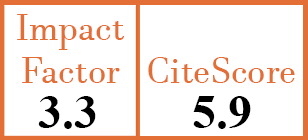Full Papers
A novel AGBL3 variant potentially associated with hypocomplementaemic urticarial vasculitis syndrome: examining clinical outcomes and therapeutic responses
B. Karacam1, I. Khan2, A. Hacisuleyman3, C. Bracaglia4, N. Abaci5, S. Sirma-Ekmekci6, A. Gül7
- Department of Genetics, Aziz Sancar Institute of Experimental Medicine, Istanbul University; Institute of Graduate Studies in Health Sciences, Istanbul University; and Department of Molecular Biology, Beykoz Institute of Life Sciences and Biotechnology, Bezmialem Vakif University, Yalikoy, Beykoz, Istanbul, Turkey.
- Department of Molecular Biology, Beykoz Institute of Life Sciences and Biotechnology, Bezmialem Vakif University, Yalikoy, Beykoz, Istanbul, Turkey; and Department of Biochemistry and Molecular Biology, College of Medicine, University of Nebraska Medical Center, Nebraska, USA.
- Department of Computational Biology, University of Lausanne, Switzerland.
- Division of Rheumatology, Ospedale Pediatrico Bambino Gesù, Roma, Italy.
- Department of Genetics, Aziz Sancar Institute of Experimental Medicine, Istanbul University, Turkey.
- Department of Genetics, Aziz Sancar Institute of Experimental Medicine, Istanbul University, Turkey.
- Division of Rheumatology, Department of Internal Medicine, Faculty of Medicine, Istanbul University, Turkey. agul@istanbul.edu.tr
CER18531
2025 Vol.43, N°10
PI 1748, PF 1752
Full Papers
Free to view
(click on article PDF icon to read the article)
PMID: 41042736 [PubMed]
Received: 14/01/2025
Accepted : 01/08/2025
In Press: 03/10/2025
Published: 23/10/2025
Abstract
OBJECTIVES:
Hypocomplementaemic urticarial vasculitis syndrome (HUVS) is a rare and severe form of urticarial vasculitis (UV), and characterised by chronic urticaria, systemic vasculitis, and hypocomplementaemia. Pathogenesis of HUVS is unknown. Genetics may play a role, and DNASE1L3 gene variants were identified in 2 families with HUVS.
METHODS:
In this study, we conducted a trio-based whole exome sequencing (WES) study to identify new candidate gene(s) in a consanguineous family with an affected son with HUVS, and the identified variant was confirmed by Sanger sequencing. Functional significance of the variant was assessed by bioinformatic tools, including molecular dynamics (MD).
RESULTS:
The patient had recurrent episodes of fever, urticarial rash, red eyes, and joint pain from age 13 along with elevated acute phase response, and increased ANA titres over time. WES analysis revealed a nonsense c.769C>T (p.Gln257Ter) variant in the AGBL3 gene, heterozygous in the parents, and homozygous in the index case. The comprehensive MD analyses demonstrated that the Gln257Ter truncation not only eliminates a portion of the protein but also fundamentally alters the structural and dynamic properties of the remaining regions.
CONCLUSIONS:
Our results indicate that AGBL3 is a novel candidate gene potentially associated with the pathogenesis of HUVS.



